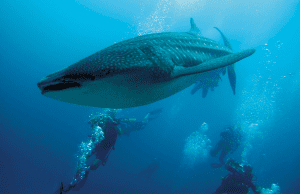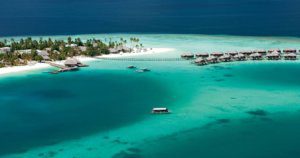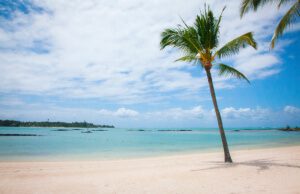Stretching between the continents of Africa, Asia, Australia, and the Indian subcontinent, the Indian Ocean is the third largest of its kind on Earth. Beyond its sheer expanse, the ocean holds a treasure trove of unique features and fascinating phenomena that beckon exploration. In this article, we embark on a journey to discover 11 interesting facts about the Indian Ocean.
1. A large number of different cetaceans inhabit the Indian Ocean

‘Big Cats’ of the ocean: The Whale Shark
The Indian Ocean teems with marine life, serving as a residence for approximately 36 species of whales and dolphins. The Indian Ocean stands as a vital habitat for these fascinating marine creatures, showcasing the region’s significance in fostering biodiversity and sustaining the delicate balance of the underwater ecosystem.
That’s why one of the most popular activities for visitors of the Indian Ocean islands is Whale Watching.
2. The Maldives are 99% water
Remarkably, a staggering 99% of the Maldives is comprised of water, underscoring the archipelago’s enchanting aquatic character. This exceptional geographical makeup not only defines the Maldives as a haven for marine enthusiasts but also shapes the nation’s cultural identity, as its people have learned to coexist harmoniously with the vast expanse of the ocean that surrounds their idyllic islands.
3. The treasure of Olivier Le Vasseur is buried in the Seychelles
Adding a touch of mystery to the azure landscapes of the Seychelles, the notorious pirate Olivier Le Vasseur is believed to have left behind a legacy of hidden treasures. Speculations swirl around the archipelago, suggesting that Le Vasseur’s final act before his demise involved burying a fortune estimated at £100,000.
4. Koba: Madagascar’s national snack
Celebrating the unique flavours of Madagascar, the island nation boasts Koba: a blend of rice, banana, and peanuts, with the form of a flavourful patty, offering a taste bud journey through the diverse agricultural riches of the region. This traditional treat not only reflects Madagascar’s rich biodiversity but also serves as a cultural emblem, inviting both locals and visitors to savour the distinctive fusion of ingredients that define the nation’s culinary heritage.
5. The curious extinction of the dodo in Mauritius
Despite its unfortunate extinction within a mere 80 years of its discovery, the dodo continues to hold a place of honour on the country’s coat of arms. Symbolizing resilience and capturing the imaginations of generations, the dodo’s enduring presence in the national emblem serves as a poignant reminder of the delicate balance between humanity and the unique biodiversity that once flourished on the remote island of Mauritius.
6. Indian Ocean is the third largest ocean in the world
The Indian Ocean stakes its claim as the third-largest ocean, covering a staggering 20% of the Earth’s surface. This immense body of water encompass 57 island groups and forming vital coastal boundaries for 16 African countries, 18 Asian nations, and Australia.
7. The Maldives are composed of more than a 1,190 coral islands

The Maldives is an archipelago composed of 1,190 coral islands, forming 26 major atolls. The term ‘atoll,’ integral to describing these coral formations, finds its roots in Dhivehi, the Indo-Aryan language spoken in the Maldives, and stands as the sole word in English derived from this language.
Among these coral islands are many luxury Maldives hotels and resorts, perfect starting points for diving excursions and other water activities to discover these natural treasures.
8. More than 250,000 species of the world’s flora and fauna live In Madagascar
Within the biodiversity hotspot of Madagascar lies a captivating treasure trove, hosting over 250,000 distinct species of flora and fauna. Astonishingly, more than 70% of this vibrant array is exclusive to the island, existing nowhere else on Earth.
9. Victoria: the smallest capital city in the world
Nestled within the idyllic Seychelles archipelago, Victoria, the capital, holds the distinction of being the world’s smallest capital city. Despite its modest size, this charming urban centre exudes a unique blend of Creole influences and colonial history, encapsulating the essence of the Seychellois way of life.
10. Mauritius boasts over 150 km of coastline

Embraced by the azure waters of the Indian Ocean, Mauritius emerges as a tropical haven adorned with over 150 kilometres of idyllic white-sand beaches. These beaches not only define the island’s breath-taking scenery but also serve as gateways to a myriad of water activities, from diving in vibrant coral reefs to strolling along the shoreline as the sun paints the sky in hues of orange and pink. There are many hidden beaches in the Indian Ocean just waiting for you to be discovered!
11. Giant tortoises living for more than a century can be found in the Indian Ocean
The latest among the curious facts about the Ocean is that In the Seychelles, the enchanting giant tortoises defy the passage of time, with some individuals boasting a lifespan that extends well beyond a century. Notably, Jonathan, a venerable giant tortoise residing on Saint Helena, is believed to have graced the Earth since 1832.
These are just some of the most interesting facts about the Ocean, to find out more immerse yourself in the Indian Ocean!
Read more
- 21 unique experiences in the Indian Ocean
- Visit our website to find out more about our luxury hotels and resorts in Mauritius, Madagascar, Maldives and Seychelles.







